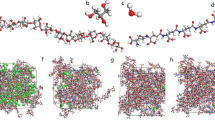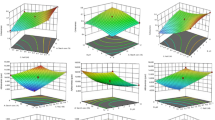Abstract
Purpose. To develop a mathematical model for predicting the molecular weight between crosslinks, Mc, of poly[Acryloyl Hydroxyethyl Starch] (Ac-HES) microspheres system and to identify and evaluate the key microsphere preparation parameters which affect the Mc of the formed microsphere structure based on the developed model.
Methods. Link probability generating functions (LPGFs) based on the classical branching theory were used to derive a model for the calculation of Mc for the Ac-HES system. Based on the developed model, simulation was made to study the effects of the microsphere preparation variables on Mc of the formed microspheres. The process variables were the degree of derivatization (DD) of the Ac-HES, the molar ratio (MR) of the Ac-HES to acrylamide monomer, the fractional conversion of the unsaturation (α), the initiator efficiency (f), the molar concentration of initiator (I), the fraction of intramolecular cyclization (c), and the total weight of the reactable monomer and polymer (s).
Results. A model to describe the crosslinking reaction of Ac-HES system and predict Mc was developed. Simulation based on the model showed that Mc decreased as α increased and reached a limiting value before total conversion. At constant α, Mc initially decreased with MR to a minimum and then increased with MR; while Mc decreased monotonically with DD. I and c affected Mc only at very low α and changes in s and f had no effect on Mc.
Conclusions. Simulation based on the model suggested that the most important microsphere preparation parameters influencing Mc of the Ac-HES system are the number of functional groups on the Ac-HES (DD) and the stoichiometry (MR) of the crosslinking reaction.
Similar content being viewed by others
REFERENCES
P. P. DeLuca and F. Rypacek. Preparation of biodegradable microspheres useful as carriers for macromolecules. US Patent 4741872, (1988).
K. Park. Biomaterials 9:435–441 (1988).
P. Artursson, P. Edman, T. Laakso, and I. Sjoholm. J. Pharm. Sci. 73:1507–1513 (1984).
D. R. Miller and C. W. Macosko. Macromolecules 9:206–211 (1976).
A. G. Mikos, C. G. Takoudis, and N. A. Peppas. Macromolecules 19:2174–2182 (1986).
A. G. Mikos and N. A. Peppas. J. Controlled Rel. 5:53–62 (1987).
D. R. Miller. J. Polymer Science:B:Polymer Physics 26:1–54 (1988).
A. B. Scranton and N. A. Peppas. J. Polymer Science:A:Polymer Chemistry 28:39–57 (1990).
M. Gordon and G. N. Malcolm. P. Roy. Soc. A. 295:29–54 (1966).
M. Gordon. P. Roy. Soc. A 268:240–259 (1962).
G. R. Dobson and M. Gordon. The J. Chemical Physics 43:705–714 (1965).
K. Dusek. Advances in Polymer Science 78:1–59 (1986).
K. Dusek and J. Spevacek. Polymer. 21:750–756 (1980).
K. Dusek and M. Ilavsky. J. Polymer Sci.: symposium 53:57–73 (1975).
J. C. Masson. In J. Brandrup and E. H. Immergut (Eds.) Polymer Handbook. 3rd ed., pp. II/1–II/59, Wiley, NY. (1989).
D. J. Currie, F. S. Dainton, and W. S. Watt. Polymer. 6:451–453 (1965).
F. A. Bovey and F. H. Winslow (Eds.) Macromolecules, an introduction to Polymer Science., pp. 36–38, Academic Press, NY. (1979).
Author information
Authors and Affiliations
Rights and permissions
About this article
Cite this article
Huang, L.K., Mehta, R.C. & DeLuca, P.P. Development of a Statistical Model for the Formation of Poly [Acryloyl Hydroxyethyl Starch] Microspheres. Pharm Res 14, 469–474 (1997). https://doi.org/10.1023/A:1012111116002
Issue Date:
DOI: https://doi.org/10.1023/A:1012111116002




